Advertisements
Advertisements
प्रश्न
With the help of a labelled diagram, show that the balancing condition of a Wheatstone bridge is
`"R"_1/"R"_2 = "R"_3/"R"_4` where the terms have their usual meaning.
Obtain the balancing condition in the case of Wheatstone's network.
उत्तर
Four resistances P, Q, R and S are connected to form a quadrilateral ABCD as shown in the following figure. A battery of emf ε along with a key is connected between points A and C such that point A is at higher potential with respect to point C. A galvanometer of internal resistance G is connected between points B and D.

When the key is closed, current I flow through the circuit. It divides into I1 and I2 at point A. I1 is the current through P and I2 is the current through S. The current I1 gets divided at point B. Let Ig be the current flowing through the galvanometer. The currents flowing through Q and R are respectively (I1 – Ig) and (I2 + Ig),
I = I1 + I2 ...(1)
Consider the loop ABDA. Applying Kirchhoff’s voltage law in the clockwise sense shown in the loop we get,
- I1P - IgG + I2S = 0 ...(2)
Applying Kirchhoff's voltage law to loop BCDB in a clockwise sense, we get,
- (I1 - Ig)Q + (I2 + Ig)R + IgG = 0 .....(3)
From these three equations (Eq. (1), (2), (3) we can find the current flowing through any branch of the circuit.
A special case occurs when the current passing through the galvanometer is zero. In this case, the bridge is said to be balanced. Condition for the balance is Ig = 0. This condition can be obtained by adjusting the values of P, Q, R and S. Substituting Ig = 0 in Eq. (2) and Eq. (3) we get,
– I1P + I2S = 0 ∴ I1P = I2S ...(4)
– I1Q + I2R = 0 ∴ I1Q = I2R ...(5)
Dividing Eq. (4) by Eq. (5), we get
`∴ ("I"_1"P")/("I"_1"Q") = ("I"_1"S")/("I"_2"R")`
`therefore"P"/"Q" = "S"/"R"`
APPEARS IN
संबंधित प्रश्न
What should be the value of R in the figure for which the current in it is zero?
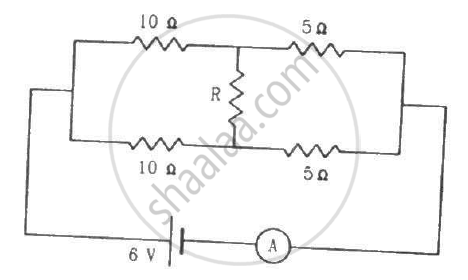
Obtain the balancing condition for the Wheatstone bridge arrangements as shown in Figure 4 below:

Choose the correct:
Four resistances 10 Ω, 10 Ω, 10 Ω and 15 Ω form a Wheatstone’s network. What shunt is required across 15 Ω resistor to balance the bridge
In Wheatstone’s meter-bridge experiment, the null point is obtained in the middle one-third portion of the wire. Why is it recommended?
State any two sources of errors in the meter-bridge experiment. Explain how they can be minimized.
Four resistances 4 Ω, 8Ω, XΩ and 12Ω are connected in a series to form Wheatstone’s network. If the network is balanced, the value of X is ______.
In a meter bridge, two unknown resistances R and S, when connected between the two gaps, give a null point is 60 cm from one end. What is the ratio of R and S?
Explain with a neat circuit diagram. How you will determine the unknown resistances using a meter bridge.
In a meter bridge, the balance point is found to be at 39.5 cm from the end A when the resistor R is 12.5 Ω (right gap).
a) Determine the resistance of X (left gap).
b) Determine the balance point of the bridge if X and R are interchanged?
c) What happens if the galvanometer and cell are interchanged at the balance point of the bridge?
The current which flows in a galvanometer of Wheatstone bridge is directly proportional to ______
With resistances P and Q placed in the left and right gaps of a metre bridge, the balance point divides the wire in the ratio of 1/3. When P and Q are increased by 40 n each. the balance point divides the wire in the ratio of 3/5. The values of P and Q will be respectively, ______
In a metre bridge experiment, the null point is obtained at 20 cm from one end of the wire when resistance X is balanced against another resistance Y. If X < Y, then where will be the new position of the null point from the same end, if one decides to balance a resistance of 4X against Y?
In the circuit shown, a metre bridge is in its balanced state. The metre bridge wire has a resistance 0.1 ohm/cm. The value of unknown resistance X and the current drawn from the battery of negligible resistance are ____________.
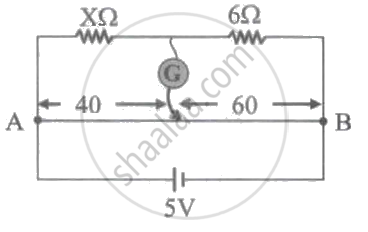
In a metre bridge experiment. the ratio of the left-gap resistance to right gap resistance is 2: 3. The balance point from the left is ______.
In Wheatstone's bridge P = 7 ohm, Q = 12 ohm, R = 3 ohm and S = 8 ohm. How much resistance must be put in parallel to the resistance S to balance the bridge?
The resistances in left and right gap of a metrebridge are 20 `Omega` and 30 `Omega` respectively. When the resistance in the left gap is reduced to half its value, the balance point shifts by ______.
In the Wheatstone bridge, (shown in the figure) X = Y and A > B. The direction of the current between a and b will be ____________.
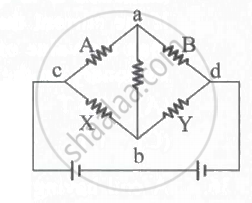
What is the e.m.f of the cell C in the circuit shown in figure, if the deflection in the galvanometer is zero, the resistance of the wire is 3 `Omega`, The length of the wire is 100 cm?
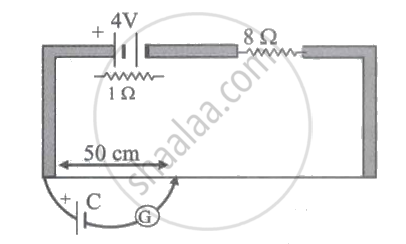
In the network shown cell E has internal resistance r and the galvanometer shows zero deflection. If the cell is replaced by a new cell of emf 2E and internal resistance 3r keeping everything else identical, then ______.
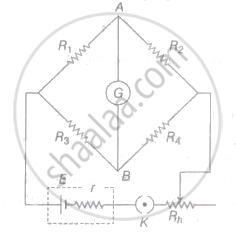
A resistance of 5 `Omega` is connected in the left gap of a metre bridge and 15 `Omega` in the other gap. The position of the balancing point is ____________.
The potential difference between the points A and B in the electric circuit shown is ______.

Which among the following resistances can be determined by a metre bridge?
In the measurement of a resistance by the Wheatstone bridge, the known and the unknown resistance are interchanged to eliminate ____________.
Two resistances prepared from the wire of the same material having diameters in the ratio 2 : 1 and lengths in the ratio 2 : 1 are connected in the left gap and right gap of Wheatstone's meter bridge respectively. The distance of the null point from the left end of the wire is ______
In the meter bridge experiment, the null point is obtained at a distance of ℓ from the left end. The resistance in the left and right gaps are halved and then interchanged. The new position of the null point is at ______
In a balanced metre bridge, 5 Ω is connected in the left gap and R Ω in the right gap. When R Ω is shunted with equal resistance, the new balance point is at 1.6 I1 where 'I1' is the earlier balancing length. The value of 'I1' is ______
In a meter bridge experiment, to minimize an error due to contact resistance, ______
In a metre bridge experiment, the ratio of the left-gap resistance to right gap resistance is 2: 3. The balance point from the left is ______.
The resistances in left and right gap of a meter-bridge are 3 `Omega` and 5 `Omega` respectively. When the resistance in the left gap is increased by 10%, the balance point shifts nearly by ______.
The current through 1 `Omega` resistance in the following circuit is ______.
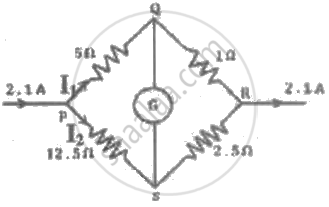
When an unknown resistance 'X' is connected in the left gap of a meter bridge and a known resistance 'R' in the right gap, a null point is obtained at 40 cm from the left end. If a 2 Ω resistance is connected in series with 'X' the null point shifts towards the right by 10 cm, with some resistance in the right gap. The value of 'X' must be ______
The Wheatstone bridge is in a more balanced state when the ratio of arms P and Q is ______
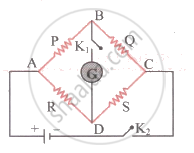
A resistance R is to be measured using a meter bridge. Student chooses the standard resistance S to be 100Ω. He finds the null point at l1 = 2.9 cm. He is told to attempt to improve the accuracy. Which of the following is a useful way?
The measurement of an unknown resistance R is to be carried out using Wheatstones bridge (figure). Two students perform an experiment in two ways. The first students takes R2 = 10 Ω and R1 = 5 Ω. The other student takes R2 = 1000 Ω and R1 = 500 Ω. In the standard arm, both take R3 = 5 Ω. Both find R = `R_2/R_1 R_3` = 10 Ω within errors.
- The errors of measurement of the two students are the same.
- Errors of measurement do depend on the accuracy with which R2 and R1 can be measured.
- If the student uses large values of R2 and R1, the currents through the arms will be feeble. This will make determination of null point accurately more difficult.
- Wheatstone bridge is a very accurate instrument and has no errors of measurement.
The figure below shows a balanced Wheatstone network. If it is disturbed by changing P to 22Ω, then which of the following steps will bring the bridge again to a balanced state?
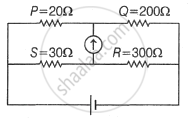
In the given circuit, if I = 100 mA and I1 = I4 = 60 mA, the currents I3 and I5 are ______.
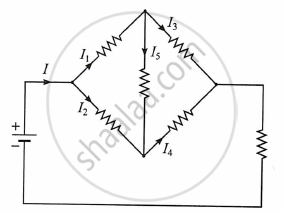
Explain the use of Wheatstone's metre bridge to determine an unknown resistance.
Draw a neat labelled diagram of Kelvin's meter bridge circuit for the measurement of galvanometer resistance.
Find the radius of the wire of length 25m needed to prepare a coil of resistance 25Ω. (Resistivity of material of wire is 3.142 x 10-7Ωm)
What is a post office box? How is the· unknown resistance measured using a post office box?
In the given Wheatstone's network, what should be the value of R for the network to be balanced?
Write balancing condition of a Wheatstone bridge.
